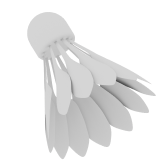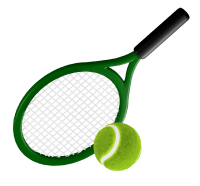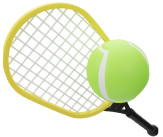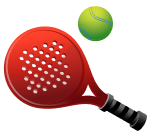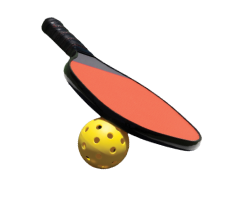Padel Tennis
Know all the basic Padel Tennis rules and regulations, how to play the
game, court lines, how to score points and more!
1. THE COURT
1.1.1 Length: 20 meters
1.1.2 Width: 10 meters (interior measurements)
1.1.3 Service Area: Service lines are located 6.95 meters from the net
1.1.4 Service Line Division: The area between the net and service
lines is divided by a central service line,extending 20 cm beyond the service line.
1.1.5 Height Requirements:
Minimum height: 6 meters (no obstructions such as spotlights)
Recommended height for new facilities: 6 meters (no obstructions such as spotlights)
1.1.6 Line Width: 5 cm, preferably white or black for contrast.
1.2 Net Specifications
1.2.1 Dimensions:
Length: 10 meters
Height: 0.88 meters at the center, rising to 0.92 meters at the ends.
1.2.2 Suspension:
Net is suspended by a metal cable (maximum diameter: 0.01 meters) attached to lateral posts (maximum height: 1.05 meters) or part of the court structure
1.2.3 Net Posts:
1.2.3.1 The posts must align with the lateral court limits.
1.2.3.2 Posts may be circular or square with rounded edges.
1.3 Court Enclosure
1.3.1 Walls:
The court must be fully enclosed, with end walls measuring 10 meters and side walls measuring 20 meters.
The material used must ensure uniform ball bounce, particularly for areas with metal fencing.
1.3.2 End Walls:
The total height must be 4 meters, with the first 3 meters as a wall (made of transparent or solid materials like glass or brick) and the top 1 meter as a metallic fence.
2. THE BALL
-
Size & Weight
Diameter: 6.35 to 6.77 cm
Weight: 56.0 to 59.4 grams
Color: White or yellow -
Bounce
The ball must bounce between 135 cm and 145 cm when dropped from a height of 2.54 meters onto a hard surface. -
Internal Pressure
The ball’s internal pressure must be between 4.6 kg and 5.2 kg per 2.54 square cm. -
Altitude Adjustments
For play above 500 meters, a different ball may be used. The bounce should be between 121.92 cm and 135cm.
3. Padel Racket
-
Structure
The racket consists of two parts: the head and the handle. -
Head
Maximum total length (head + handle): 20 cm
Maximum width: 50 mm
Maximum thickness: 50 mm -
Handle
Maximum length: 45 cm
Maximum width (throat): 6 cm
Maximum thickness: 38 mm -
Wrist Cord
The racket must have a non-elastic wrist cord (max length: 35 cm) for safety, and its use is mandatory. -
Surface
Both sides of the racket must be flat, with either a smooth or rough texture.
4. Score in a Game
4.1 Traditional Scoring
4.1.1 Point Scoring
-
First point: “15”, second point: “30”, third point: “40”, fourth point: “Game”.
-
If both pairs win three points each, it’s “Deuce”. The next point won gives an “Advantage”. If the same pair wins the next point, they win the game; if not, the score returns to “Deuce”.
-
First pair to win 6 games, with a minimum 2-game advantage, wins the set
-
If tied at 5-5, play continues until 7-5
-
If tied at 6-6, a “tie-break” is applied.
4.1.3 Match Format
- Best of 3 sets. Two sets must be won to win the match.
4.1.4 Third Set (No Tie-Break)
- In case of a 1-1 set tie, the third set may be played without a tie-break. If tied at 6-6, the first pair to gain a 2-game lead wins.
4.2 No Advantage Scoring
- First point: “15”, second point: “30”, third point: “40”, fourth point: “Game”.
- If tied at 3 points (Deuce), a “Golden Point” is played. The receiving pair chooses which side to receive from but cannot change positions.
- In the Golden Point, the receiver must be of the same gender as the server.

4.3 Tie-Break Rules
- Points are called: 0, 1, 2, 3, etc.
- The first pair to win 7 points with a 2-point advantage wins the tie-break and the set.
- The player serving first in the set serves once from the right. The opposing team serves two points starting from the left.
- Players alternate serving two points until the tie-break ends.
- A tie-break set is won by 7-6.
- The player who did not serve first in the tie-break serves to start the next set.
4.4 Alternative Scoring Methods
- The first pair to win 4 games wins the set, with a minimum 2-game margin. If tied at 4-4, a tie-break is played.
- When tied at one set each, a 7-point tie-break is played to decide the match.
- When tied at one set each, a 10-point tie-break is played to decide the match.
5. Times
-
Walkover
5.1.1 A “walkover” will be awarded if a player is not ready to play 10 minutes
after the official start time, except for force majeure cases. -
Match Scheduling
5.2.1 When matches are scheduled consecutively, the next match starts 5 minutes
after the previous one ends. -
Warm-up
5.3.1 A maximum of 20 seconds is allowed between points -
Rest Period Between Sets:
5.4.1 A maximum rest period of 120 seconds is allowed between sets -
Tie-break Side Changes
5.5.1 20 seconds is allowed for side changes during a tie-break.
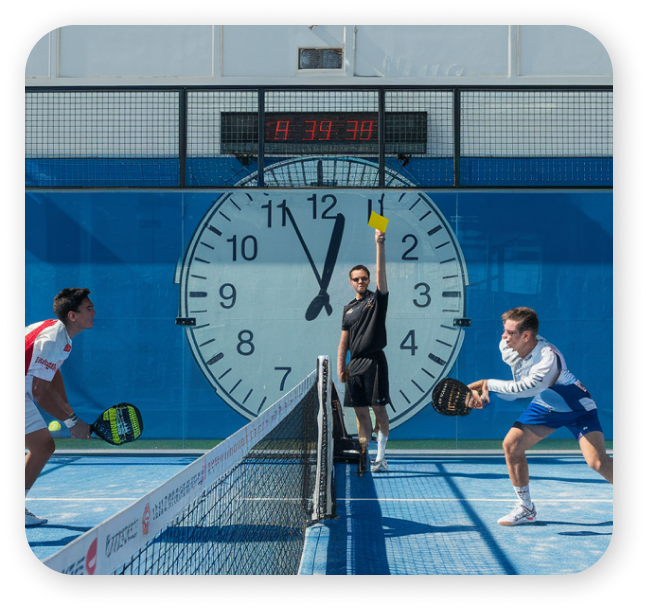
-
Side Changes5.6.1 A maximum of 90 seconds is allowed for changing sides after each game. No rest is granted during a tie-break, and play is continuous.
-
Match Suspension5.7.1 In case of suspension (due to rain, light issues, accidents), the warm-up time upon restart depends on the length of the suspension:5.7.1.1 Up to 5 minutes: No warm-up
5.7.1.2 5-20 minutes: 3-minute warm-up
5.7.1.3 Over 20 minutes: 5-minute warm-up
6. Choice of Sides and Service
6.1 Deciding Sides and Service
6.1.1 The choice of sides and service order is decided by a coin toss. The pair that wins the toss can choose one of the following options:
A. Choose to serve or receive first, and the opposing pair chooses the side.
B. Choose the side of the court for the first game, and the opposing pair chooses whether to serve or receive.
C. Request that the opponents make the first choice.
7. Changes of Sides
-
General Rule for Changing Sides
7.1.1 Players must change sides after the 1st, 3rd, and every subsequent odd game in the set -
Tie Break
7.2.1 In the tie break, players will change ends after every 6 points. -
Correcting Errors
7.3.1 If players fail to change sides as required, the correction must be made immediately once the mistake is discovered, following the correct order
7.3.2 All points won before the error was discovered are valid. If the error is found after a faulty first serve, the server only has one serve remaining
7.4 Case Decisions
Case 1 : At the end of a set, we have a 120-second rest period. Do we have to change sides to start the next set?
Decision:
Yes, if the total number of games played before the rest period adds up to an odd number, you must change sides.
No, if the total number of games adds up to an even number, no side change is required.
Case 2 : At the end of the 1st game of each set, we have to change sides. Are we allowed a rest period?
Decision:
No, The game must be continuous. There is no rest period after the 1st game of each set; players must change sides and continue the game.
8. The Service
-
Position for Serving
8.1.1 The server must stand with both feet behind the service line, between the imaginary extension of the central line and the sidewall (service box), and remain in this position until the ball is served.
-
Ball Bounce
8.2.1 The server must bounce the ball within the service box where they are standing before serving.
-
Feet Position
8.3.1 The server’s feet must not touch the service line or the imaginary central line.
-
Height of the Serve
8.4.1 The ball must be served at or below waist level when making contact, and at least one foot must remain in contact with the ground.
-
Serving Direction
8.5.1 The ball is served from the right side of the court, diagonally into the receiver’s box.
8.5.2 On the first serve, the ball must land in the receiver’s left-side service box. After each point, the server alternates serving to the right-side service box and left-side service box.

-
Movement During Service
8.6.1 The server may not walk, run, or jump while serving.
8.6.2 Small foot movements, which do not affect the server’s position, are allowed.
-
Service Attempt
8.7.1 Once the server attempts to hit the ball, it is considered a serve.
-
Wrong Side Service
8.8.1 If a serve is made from the wrong side, the error must be corrected immediately.
8.8.2 All points played before the mistake are valid.
8.8.3 A fault on the first serve must still be accounted for.
-
Choosing Who Serves First
8.9.1 Before the start of each set, the pair decides who will serve first.
8.9.2 Once decided, the server order cannot change until the next set.
-
Serving Out of Turn
8.10.1 If a player serves out of turn, the correct server must serve immediately upon discovery.
8.10.2 All points won before the error are valid.
8.10.3 If the error is not discovered before the set ends, the server order remains as is for the rest of the set.
-
Readiness of the Receiver
8.11.1 The server will not serve until the receiver is ready.
8.11.2 The receiver must adapt reasonably to the server’s rhythm and be ready when the server is ready.
-
“Not Ready” Call
8.12.1 A “not ready” call cannot be made if the receiver has already attempted to return the serve.
8.12.2 If it is proven that the receiver was not ready at the time of the serve, a “fault” cannot be called.
-
Case Decisions
Case 1: At the end of a set, we have a 120-second rest period. Do we have to change sides to start the next set?
Decision:Yes, if the total number of games played before the rest period adds up to an odd number, you must change sides.
No, if the total number of games adds up to an even number, no side change is required.
9. Service Fault
-
Infringement of Service Rules
9.1.1 If the server breaks any of the service rules from Rule 6 (points 1–6) in the set. -
Missed Ball
9.2.1 The server misses the ball entirely while attempting to hit it. -
Bounce Outside the Service Box
9.3.1 If the ball bounces outside the receiver’s service box (lines are considered in, meaning they count as valid). -
Ball Hits the Server or Their Equipment
9.4.1 If the ball hits the server, their partner, or any object they are wearing or carrying. -
Ball Hits the Fence Before Second Bounce
9.5.1 If the ball bounces in the receiver’s service box, but hits the metallic fence before the second bounce. -
Ball Bounces Out of Court Through the Gate
9.6.1 If the ball bounces in the receiver’s service box and then bounces out of the court through the gates (in courts without a safety zone, which are not authorized for out-of-court play).

Case 1 : You served, and the ball hits the wall, light, or the fence on your side of the court before crossing the net into the receiver’s service box.
Decision: No, it is a fault.
Case 2 : You served a lob, and the ball bounces in the receiver’s box and then goes directly out of the court over the metallic fence.
Decision: No,This is not a fault.
10. Return of Server
-
Basic Return
10.1.1 The receiver must let the ball bounce in their service box and hit it before the second bounce. -
First Receiver Decision
10.2.1 In the first game of each set, the receiving pair decides who will receive first and continue receiving first serves throughout the set. -
Order of Receiving
10.3.1 Players alternate receiving serves. Once set, the order cannot change during the set or tie-break, but can change at the start of a new set. -
Altered Receiving Order
10.4.1 If the order is changed during a game/tie-break, the players must continue until the game ends, then return to the original order for the rest of the set. -
Fault for Hitting the Receiver
10.5.1 If the ball hits the receiver or their racket before bouncing in the service box, it’s a fault, and the server wins the point.
-
Case DecisionCase 1: On old courts with a wall and metallic fence not aligned, the serve is valid only if the ball bounces in the service box, hits the ledge, and exits toward the receiver along the imaginary line from the ledge.
Case 2: If the ball bounces twice in the service box, even if it hits the wall, it’s a fault. The server wins the point.
Case 3: The receiver cannot volley outside the service reception box. If they do, it’s a fault.
11. Repeat or “Let” and “Net” Service
11.1 Service “Net”
A serve is a “net” if:
- The ball touches the net or posts and lands in the receiver’s service box (without touching the metallic fence before the second bounce).
- The ball hits the net or posts and then touches a player or their equipment.
11.2 Service “Let”
A service is a “let” (and replayed) if:
- The receiver is not ready (Rule 6 – 11).
- The ball hits the net or posts and then touches a player or their equipment.
- If the “net” or “let” occurs on the second serve, only the second serve is repeated.
11.3 Case Decisions
Case 1 : The ball touches the net on serve, lands in the receiver’s service box, but the second bounce causes the ball to go out of court through a gate/opening.
Decision:
Let: If the ball can be played outside the court.
Fault: If the ball cannot be played out of the court (e.g., it’s blocked by the opening or gate)
.
12. Repetition or “Let” Point
12.1 A “let” occurs and the point is replayed if
- The ball splits during play.
- An external element invades the court.
- Any unexpected disruption happens.
- The umpire decides if the “let” is valid. If not, the player loses the point.
12.2 Case Decisions
Case 1: If the first serve is a fault, and a “let” occurs after the second serve, the entire point is replayed with the server getting two serves.
13. Interference
13.1.1 Deliberate Interference
If a player deliberately interferes with the opponent’s shot, the umpire will award the point to the opponent.
13.1.2 Involuntary Interference
If the interference is unintentional, the umpire will call a “let” and the point is replayed.
14. Ball in Play
-
Ball in Play
14.1.1 The ball is hit alternately by the players.14.1.2 The ball remains in play from the valid serve until a “let” or score determination.14.1.3 If the ball hits any part of the court (after bouncing on the opponent’s side), it stays in play and must be returned before a second bounce.14.1.4 Parts of the court include walls, fence, ground, net, and net posts. The entire fence (mesh and frame) counts as part of the court. -
Case Decisions
Case 1: If the ball hits the fence frame (upper part), the game continues if the ball bounces back inside the court or goes out of the court (if allowed for out-of-court play).

15. point lost

A player will lose the point if:
-
Touching the Net or Opponent’s Court:15.1.1 The player, their racket, or anything worn/carrying touches the net, net posts, tension cable, or any part of the opponent’s court while the ball is in play.
-
Out-of-Court Play15.2.1 If the ball bounces a second time before being returned.15.2.2 If the ball goes over the court’s outer perimeter or through the gate after bouncing.15.2.3 If the ball bounces correctly but then goes out of court over the end wall (or hits the sidewall/door).
-
Incorrect Hit or Return15.3.1 If the player hits the ball before it crosses the net.15.3.2 If the ball is returned and touches any part of the opponent’s court (walls, fence, etc.) without bouncing first.15.3.3 If the ball hits the net or net posts and then goes to the opponent’s court or any non-court element.15.3.4 If a player hits the ball twice (double hit).
-
Player and Equipment15.4.1 If the ball touches the player, their partner, or anything they wear.15.4.2 If the ball hits the metallic fence or any part of their own court.15.4.3 If the ball is hit with a racket thrown at it.15.4.4 If the player jumps over the net during play.15.4.5 If both players hit the ball at the same time (double hit).
-
Out of Court15.5.1 If the player has any part of their body outside their court while hitting the ball (unless authorized for out-of-court play).15.5.2 If the server serves two consecutive faults.
-
Case DecisionsCase 1: If the ball bounces correctly in your court but does not leave the court due to an additional net above the metallic fence, the point is lost.
16. Correct Return
A player will lose the point if:
-
Volley or Body Contact
16.1.1 The ball is volleyed by the opponent or hits any part of the opponent’s body,
clothing, or racket. -
Bounce in Opponent’s Court
16.2.1 The ball bounces directly into the opponent’s court or hits a wall in your
court before bouncing into the opponent’s court -
Bounce and Fence/Wall
16.3.1 The ball bounces in the opponent’s court and then hits the metallic fence or a
wall. -
Out of Court after Bounce
16.4.1 The ball bounces in the opponent’s court and then goes out of court, hits the
ceiling, lights, or any object not related to the court. -
Net or Posts16.5.1 The ball touches the net or net posts and then lands in the opponent’s court.

-
Object in Opponent’s Court16.6.1 The ball hits an object in the opponent’s court (not part of the court) after bouncing correctly.
-
Back to Server’s Court16.7.1 The ball bounces correctly in the opponent’s court, goes back into the server’s court, and then is hit by the opponent. (No touch of the net or opponent’s court by the player or their equipment).
-
Scooped or Pushed16.8.1 The ball is scooped or pushed, provided there is no double hit and the movement is continuous.
-
Bounce in a Corner16.9.1 The ball bounces in the corner where the wall meets the ground (called an “egg”)
-
Out-of-Court Play16.10.1 The ball is hit from outside the court and meets the above conditions.
-
Case DecisionsCase 1: If the ball bounces on an object (not part of the court) in the opponent’s court, the return is still correct, but you do not win the point. The game continues.
17. Point Won
A point is won if:
-
Out of Court After Bounce17.1.1 The ball bounces in the opponent’s court and goes out through a hole in the metallic fence or gets stuck in the hole.
-
Stuck on Wall17.2.1 The ball bounces in the opponent’s court and gets stuck on the flat horizontal surface on top of the wall.
18. Authorized Out-of-Court Play
-
Players are authorized to leave the court to play the ball as long as the court meets the conditions for safety and out-of-court play as per the court regulations.
19. Change of Balls
-
Ball Policy Announcement19.1.1 Organizers must specify the ball brand, number of balls (2 or 3), and ball change policy in advance.
-
Ball Change Timing19.2.1 Balls are changed after an odd number of games, or at the start of a set.19.2.2 No ball change at the beginning of a tie-break; it happens at the second game of the next set.19.2.3 If a ball change is missed, it’s corrected when the team serving next is due for the change.
-
Damaged/Lost Balls19.3.1 If a ball is lost, broken, or differs from others, the umpire will replace it with a matching ball.
-
Ball Availability19.4.1 At least two balls must be available for play at the start of each point.
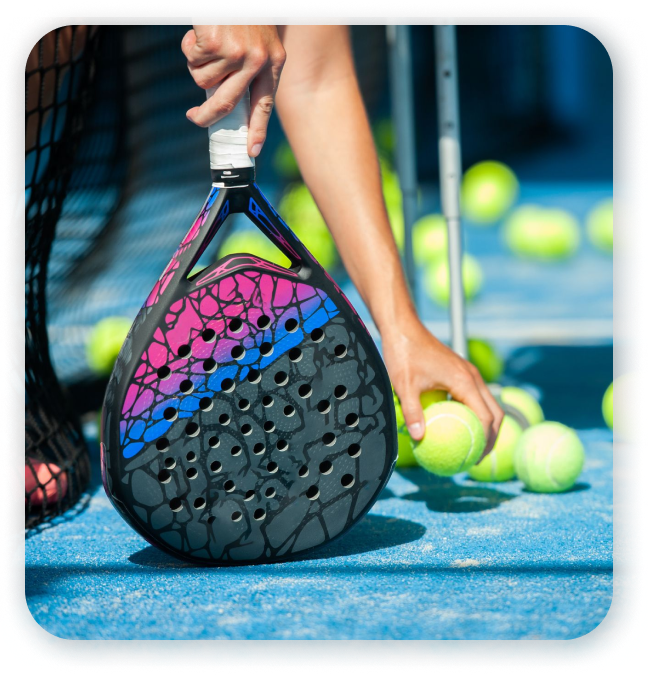
This content is derived from the “Regulations of the Padel Game” by the Federación Internacional Padel (FIP).

